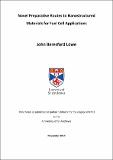Files in this item
Novel preparative routes to nanostructured materials for fuel cell applications
Item metadata
| dc.contributor.advisor | Baker, Richard | |
| dc.contributor.author | Lowe, John Beresford | |
| dc.coverage.spatial | XI, 236 p. | en_US |
| dc.date.accessioned | 2017-10-30T14:34:48Z | |
| dc.date.available | 2017-10-30T14:34:48Z | |
| dc.date.issued | 2014-11 | |
| dc.identifier.uri | https://hdl.handle.net/10023/11949 | |
| dc.description.abstract | Nanostructured materials with high specific surface areas and high pore volumes are of interest for applications in solid oxide fuel cells (SOFCs). This study describes the use of novel preparative methods for obtaining nanostructured samarium-doped ceria (SDC) with a view to its application as an anode material in SOFCs. The strategy employed in this work was based on the nanocasting concept. Template materials with a polymer, carbon or silica framework are first obtained using a self-assembly process. These materials have long range networks of ordered mesopore channels and so act as templating moulds. From a three step procedure of precursor impregnation, in-situ formation of SDC by calcination and template removal, SDC with the inverse pore structure of the template is created. Novel methods for producing such SDC materials were applied and the products evaluated. As silica templates have wide ranging applications involving exposure to high temperatures -not least in nanocasting- it was desirable to understand the thermal stability of these materials over a range of temperatures. A systematic study was conducted on three representative silica templates. An inherent problem in nanocasting from silica templates is retention of residual silica after the template removal step. A detailed investigation into these alternative wet chemistry procedures was undertaken. To circumvent the silica problem completely, a number of alternative templates made of mesoporous carbon were considered. A range of ordered mesoporous carbons were prepared and evaluated as templates. To provide a comparator for the ordered SDC materials, a simple combustion method was used to prepare an SDC product without the influence of a structure directing template. The techniques of TEM, SEM-EDX, UV–Vis spectroscopy, MAS-NMR, PXRD and gas physisorption were used to characterise the physical and chemical properties of the products in the bulk and at the nanoscale. | en_US |
| dc.language.iso | en | en_US |
| dc.publisher | University of St Andrews | |
| dc.subject.lcc | TK2933.S65L7 | |
| dc.subject.lcsh | Solid oxide fuel cells--Materials | en |
| dc.subject.lcsh | Nanostructured materials | en |
| dc.title | Novel preparative routes to nanostructured materials for fuel cell applications | en_US |
| dc.type | Thesis | en_US |
| dc.contributor.sponsor | University of St Andrews. School of Chemistry | en_US |
| dc.type.qualificationlevel | Doctoral | en_US |
| dc.type.qualificationname | PhD Doctor of Philosophy | en_US |
| dc.publisher.institution | The University of St Andrews | en_US |
This item appears in the following Collection(s)
Items in the St Andrews Research Repository are protected by copyright, with all rights reserved, unless otherwise indicated.

